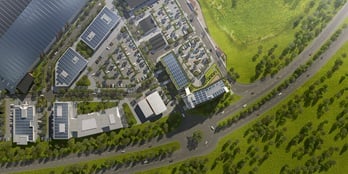Data centre boom drives competition for sites
By proceeding you confirm that you are a resident of Australia or New Zealand accessing this website from within Australia or New Zealand and you represent, warrant and agree that:
- you are not in the United States or a “U.S. person”, as defined in Regulation S under the U.S. Securities Act of 1933, as amended (“U.S. Person”), nor are you acting for the account or benefit of a U.S. Person;
- you will not make a copy of the documents on this website available to, or distribute a copy of such documents to, or for the account or benefit of, any U.S. Person or any person in any other place in which, or to any other person to whom, it would be unlawful to do so; and
- the state, territory or province and postcode provided by you below for your primary residence in Australia or New Zealand are true and accurate.
Unfortunately, legal restrictions prevent us from allowing you access to this website. If you have any questions, please contact us by e-mail by clicking on the link below.
Our digital world generates data at an ever-accelerating rate. By some estimates 90 per cent of all the world’s data was created in just the past two years, and by 2021 we will be generating two megabytes of data per person per second.
If data is the ‘new oil’ then data centres are the new service stations, and in Australia as elsewhere around the world investment in the sector is surging, with billions of dollars in new projects announced locally over the past year.
Our National Industrial Delivery Manager Matthew Cox says while we are not currently active in this space, it’s an area that is increasingly becoming a focus for us.
“There’s very strong demand in the market,’’ says Matthew. “We're getting multiple requests from tenants or prospective tenants to provide proposals to either build data centres or provide land for them.
“And our own modelling indicates ongoing continuous requirements. Obviously as we generate more and more data we need more places to store it—and multiple places, given the need for redundancy.’’
But data centres have unique, hard-to-meet requirements when it comes to site selection, and this is sparking intense competition between Australian operators, says David Sanders, director at FDC Construction & Fitout, a Charter hall partner and Australia’s leading data centre construction firm.
“Data centre operators fight very competitively over sites, and they are very covert in their initial operations to identify them and then to try to negotiate a position on them,’’ says David. “They might spend months or even years trawling the market to find a suitable location.’’
Their primary considerations are access to power and fibre networks.
“They need multiplicity of high-voltage power supply,’’ says David. “It’s about supply opportunities coming from feeds from disparate zone substations, so if there's a problem with one then you’ve still got a power feed coming in from an alternate source.
“And then they take a similar overlay with regards to optical fibre networks and the exchanges through which the data goes. Again it's all about redundancy, so if a roadworks crew digs through a cable, you're still live through the alternate route.’’
When it comes to construction, data centres share characteristics of both commercial and industrial buildings, says David. Depending on the site, operators may opt for single-level, but multi-storey buildings often make more sense.
“These are more industrial to the extent that the floor loadings approximate those of multi-level warehousing, so they tend towards that sort of style of construction,’’ he says.
The heavy investment in infrastructure required is a strong incentive to maximise returns by building upwards.
“For example we are currently working on a multi-level data centre for NEXTDC at Macquarie Park,’’ says David. “The land’s expensive, and there's a lot of money involved in bringing the infrastructure to the site.
“With several dedicated high-voltage feeds and several dedicated fibre feeds they're investing a lot of time, effort and money in the infrastructure so they need to optimise their bang for buck.’’
In such situations it makes sense to build with a long-term view to catering for future growth.
“Data Centre operators may build four floors, with three or four data halls on each floor, and then progressively fit-out floor by floor in response to demand as their sales teams deliver,’’ says David.
“A large client such as a bank might take a whole data hall or even a floor of a building at a time, whereas smaller operators may only take enough space to put one rack in.
“It’s not just the big end of town that needs data centres, more moderate-sized businesses are looking to data centres for disaster recovery and even normal business operations.’’
Globally, the industry has experienced compound average growth of over 12 per cent over the past five years. In Australia, data centre operators are confident that ongoing competition between hyperscale cloud providers like Amazon Web Services, Microsoft Azure, Google Cloud, SAP Cloud, Oracle and Alibaba for market share, combined with increased demand from corporate and government organisations, continue to justify further investment.
David says FDC Construction is expecting to see the high levels of activity sustained, given the level of interest in the market.
“We're certainly seeing continued growth at this stage based on the bullish behaviour of the operators,’’ he says.


